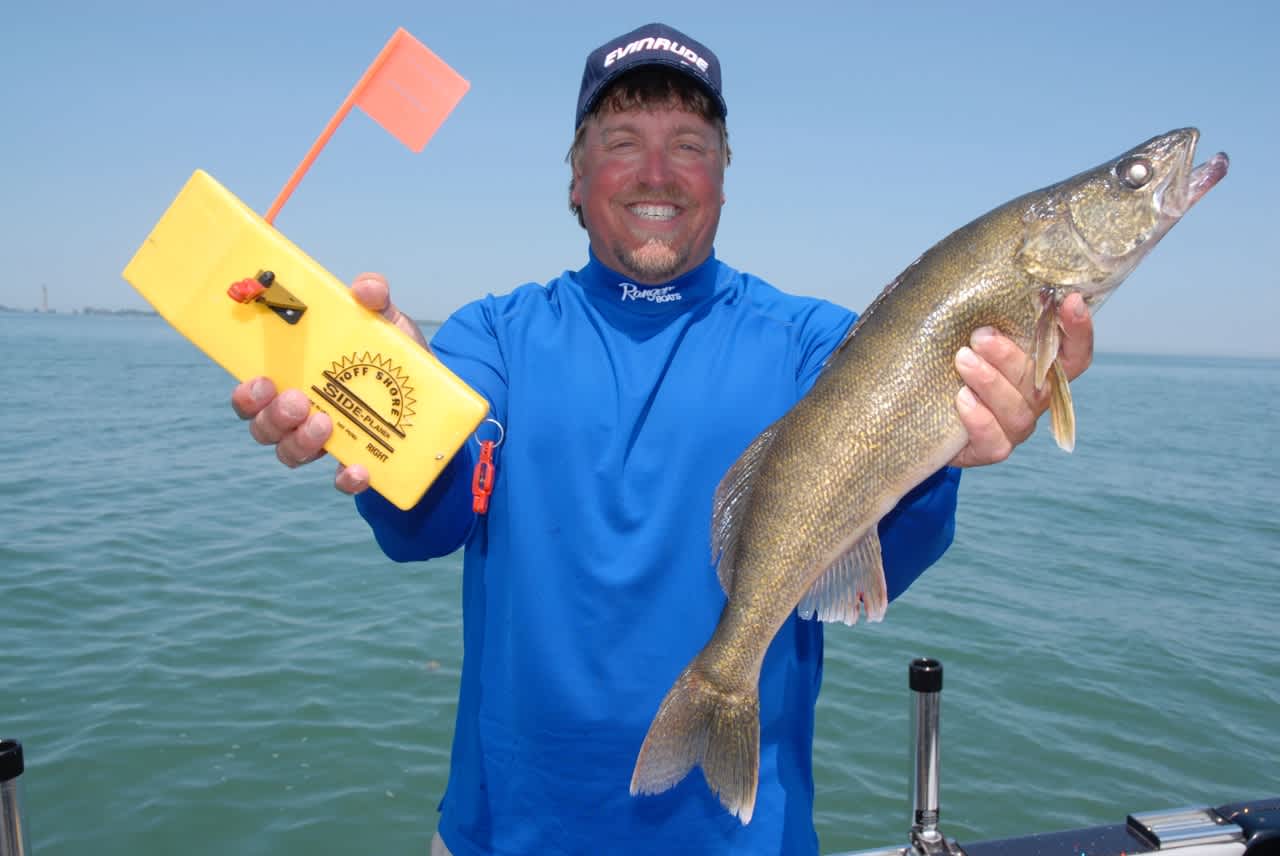Using Planer Boards to Catch Suspended Walleyes
Bernie Barringer 07.18.14

Walleyes suspend over open water during the summer and most anglers give up on trying to catch them. With a small investment in time and money you can be catching overlooked walleyes with this nifty tool.
Whether they’re shad in reservoirs, shiners in large river systems, or ciscoes in natural lakes, schools of baitfish draw large numbers of walleyes in the summer. The baitfish move around a lot, and the walleyes, loosely schooled and traveling, follow the food. Because they are so spread out and can be at virtually any depth, these fish become very hard for the angler to catch. In fact, many walleye fishermen concentrate on the fish that are easier to catch along the deep weedlines and rock humps while giving up on the often larger suspended fish altogether.
That’s just fine with anglers who know how to catch them with planer boards. Among those would be Tommy Skarlis, a walleye pro who has refined the art of trolling with planer boards to a high level. In fact, Skarlis holds the record for the largest catch of walleyes ever brought to the scales in a professional tournament. Over a three-day event, his 15-fish limit weighed 138 pounds. Don’t bother to reach for your calculator; I already did, that’s a 9.2-pound average.

A lot of anglers were catching fish and bringing in big limits in that Lake Erie tournament, but Skarlis dialed them in better. “I found that there were fish to be caught at many depths, but it seemed like the biggest fish consistently came from 11 to 12 feet below the surface,” he said. “But I have often seen big walleyes only five feet below the surface. There is really no way to catch these fish that’s even close to as effective as planer boards.”
Many walleye anglers are structure oriented, and that’s with good cause, but in many lakes and reservoirs, these suspended fish get really big because few people are targeting them. “The structure is the bait,” Skarlis told me. “You find the schools of baitfish and you will find walleyes relating to them.”
Skarlis starts out by spreading the boards out and combing the depths. By varying the length of line behind the boards he can control how deep the baits dive, and he also uses different baits that run at different depths. He normally starts out running four lines, two on each side of the boat, putting baits at five, ten, fifteen and 20 feet or near the bottom. When he gets a bite, he begins to adjust the other lines until he has a pattern figured out.
One of the significant advantages of trolling with planer boards is their ability to catch fish that are either shallow or well up in the water column. If you are trolling a bait behind your boat and the walleyes are only five feet down, you aren’t going to catch very many because the boat will spook the fish, particularly in clear water. Where do the spooked fish go? Why right of to the side of course, and that’s where you planer board is running your bait.
The same is true of fishing in shallow water. Walleyes often come up on shallow flats to feed and chase baitfish. Crankbaits or spinners attached to planer boards spread out your lines, covering more water, and anything that is spooked by the boat motor running directly over them moves right off to the side and runs smack into your bait. Perfect.

Skarlis has another trick up his sleeve when it comes to trolling with planer boards. “Too many people just troll in a straight line. That’s boring. I mix it up a little, making S-curves and driving erratically. As you turn, the baits on the outside of the turn speed up and dive deeper, while the ones on the inside slow down and rise a little. You’d be surprised how often this little variation triggers a bite.”
Is fishing with planer boards for you? If you have a boat, you can find fish with planer boards and they are likely to be bigger fish than you are catching elsewhere because they aren’t being targeted as much.
This technique requires and investment. A set of four Off Shore side planers and rod holders to mount to your boat will set you back a couple hundred bucks, but you are set for a lifetime. If one comes off the line, which they occasionally do when you catch a big fish, you just turn around and go back to get it. Planer boards last a long time, and when you consider the value of them in the increased number of fish you will be catching, they’re a savvy investment. Give them a try.
Follow Bernie’s bowhunting adventures on his blog, bowhuntingroad.com.

